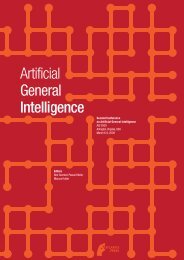Algorithmic Learning Theory - of Marcus Hutter
Algorithmic Learning Theory - of Marcus Hutter
Algorithmic Learning Theory - of Marcus Hutter
Create successful ePaper yourself
Turn your PDF publications into a flip-book with our unique Google optimized e-Paper software.
2 <strong>Marcus</strong> <strong>Hutter</strong>, Rocco A. Servedio, and Eiji Takimoto<br />
technique for comparing distributions without the need for density estimation<br />
as an intermediate step. The approach relies on mapping the distributions into<br />
a reproducing kernel Hilbert space, and has a range <strong>of</strong> applications that were<br />
presented in the talk.<br />
Masaru Kitsuregawa works on data mining, high performance data warehousing,<br />
high performance disk and tape arrays, parallel database processing,<br />
data storage and the Web, and related topics. His invited lecture for DS 2007<br />
was about “Challenges for Info-plosion.”<br />
Thomas G. Dietterich studies topics in machine learning including sequential<br />
and spatial supervised learning, transfer learning, and combining knowledge<br />
and data to learn in knowledge-rich/data-poor application problems. He works<br />
on applying machine learning to a range <strong>of</strong> problems such as ecosystem informatics,<br />
intelligent desktop assistants, and applying AI to computer games. His<br />
invited lecture for DS 2007 discussed the role that machine learning can play in<br />
ecosystem informatics; this is a field that brings together mathematical and computational<br />
tools to address fundamental scientific and application problems in<br />
the ecosystem sciences. He described two on-going research efforts in ecosystem<br />
informatics at Oregon State University: (a) the application <strong>of</strong> machine learning<br />
and computer vision for automated arthropod population counting, and (b)<br />
the application <strong>of</strong> linear Gaussian dynamic Bayesian networks for automated<br />
cleaning <strong>of</strong> data from environmental sensor networks.<br />
Jürgen Schmidhuber has worked on a range <strong>of</strong> topics related to learning, including<br />
artificial evolution, learning agents, reinforcement learning, metalearning,<br />
universal learning algorithms, Kolmogorov complexity and algorithmic probability.<br />
This work has led to applications in areas such as finance, robotics, and<br />
optimization. In his invited lecture (joint for ALT 2007 and DS 2007), Jürgen<br />
spoke about the algorithmic nature <strong>of</strong> discovery, perceived beauty, and curiosity.<br />
Jürgen has been thinking about this topic since 1994, when he postulated that<br />
among several patterns classified as “comparable” by some subjective observer,<br />
the subjectively most beautiful is the one with the simplest (shortest) description,<br />
given the observer’s particular method for encoding and memorizing it. As<br />
one example <strong>of</strong> this phenomenon, mathematicians find beauty in a simple pro<strong>of</strong><br />
with a short description in the formal language they are using.<br />
We now turn our attention to the regular contributions contained in this<br />
volume.<br />
Inductive Inference. Research in inductive inference follows the pioneering<br />
work <strong>of</strong> Gold, who introduced a recursion-theoretic model <strong>of</strong> “learning in the<br />
limit.” In the basic inductive inference setting, a learning machine is given a<br />
sequence <strong>of</strong> (arbitrarily ordered) examples drawn from a (recursive or recursively<br />
enumerable) language L, which belongs to a known class C <strong>of</strong> possible languages.<br />
The learning machine maintains a hypothesis which may be updated after each<br />
successive element <strong>of</strong> the sequence is received; very roughly speaking, the goal<br />
is for the learning machine’s hypothesis to converge to the target language after<br />
finitely many steps. Many variants <strong>of</strong> this basic scenario have been studied in<br />
inductive inference during the decades since Gold’s original work.













